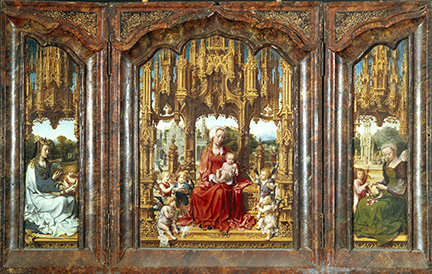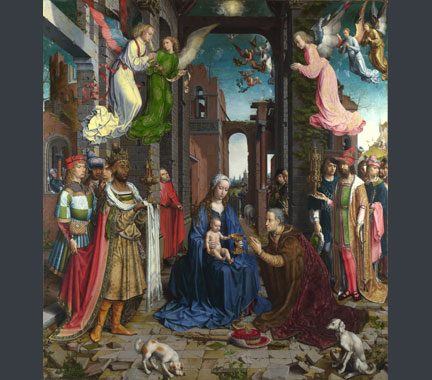Biography and invention
Art historians have created for Jean Gossart various different biographies. Ainsworth, for example, accepted that Gossart worked in Antwerp between 1503 and 1508; and then proposed that, after his return from Rome in 1509 and before his move to Utrecht in 1517, he spent some time in Bruges and worked there in collaboration with Gerard David. She identified Gossart as the ‘Janin de Waele’, Janin the Walloon, who in 1509 joined the Confraternity of Our Lady at Middelburg. The profession of this Janin (Little John) was not stated: there could have been several Little Johns from Wallonia in Middelburg. There is no proof that Gossart lived in Middelburg, though later, between 1518 and 1520, he was to work on a large polyptych for the abbey there. Ainsworth believed that Gossart might have remained based in Middelburg after 1509, which is some 45 km from Bruges. No trace of Gossart has been found in the records of the Bruges Guild of Saint Luke, which are reasonably complete, or in the Bruges archives.

The Malvagna Triptych (Palermo: fig.13) is signed by Gossart. According to Ainsworth it was a collaborative work: she maintained that David painted the Virgin and Child and the female saints, while Gossart contributed the architecture, cherubs and angels. On the outsides of the wings, again according to Ainsworth, Gossart painted the figures of Adam and Eve and the architecture, while David painted the landscape.32 There does not seem to be any method in this proposed specialisation and collaboration. Ainsworth saw the ‘Adoration of the Kings’ (NG2790: fig.6) as the work of Gossart, who twice signed the picture, except for the two figures and especially the heads of the Virgin and Child, which she credited to David.

It is not impossible that Gossart may have collaborated with other artists and that other artists may have made contributions to pictures signed by him. Patinir, after all, signed the ‘Temptations of Saint Anthony’ (Prado), where the figures are by Quinten Massys;33 and Hans Vredeman de Vries signed twice, once in Latin and once in Greek, his ‘Christ in the House of Martha and Mary’, dated 1566 (Royal Collection), where figures by an artist close to Beuckelaer were later replaced by Anthonis Blocklandt.34 Other collaborations of the sixteenth and seventeenth centuries were between specialists, each of whom contributed according to his expertise in figures, landscape, interiors, animals or still life. In Ainsworth’s theory of a ‘prestige collaboration’ between Gossart and David, Gossart was supposed to have contributed architectural detail and subsidiary figures, while David provided the principal figures, especially the Virgin and Child, the female saints and parts of landscapes, but stylistic evidence does not support these conclusions.
The following summary biography is based on a more cautious evaluation of the historical and stylistic evidence. Jean Gossart seems to have had parents prosperous enough to afford to have one son, Jean, trained as a painter and another son, Nicaise, educated in engineering or architecture. The large towns nearest to Maubeuge were Mons and Valenciennes, where Simon Marmion died in 1489. Jean may have studied there but probably moved on to Brussels, where he would have encountered the work of Hugo van der Goes and some of his followers,35 and Antwerp, where he may have become a master of the Guild of Saint Luke in 1503–4, at the relatively early age of 26. The painters of Antwerp and Brussels were linked in various ways and it was perhaps in Brussels that Jean attracted the attention of his principal patron Philip, Bastard of Burgundy, who maintained a house there. It is very likely that Philip took Gossart with him when he went to Rome in the winter of 1508–9, that Gossart remained in Philip’s service and that he lived in his residences in Brussels, Souburg and Utrecht. During that period, Gossart worked for other patrons, presumably with Philip’s permission. After Philip’s death in 1524, Gossart worked for Adolf of Burgundy, Lord of Veere, and seems to have lived at Veere. In 1532, the last year of his life, Gossart was receiving a pension from Mencía de Mendoza, Countess of Nassau.
Gossart’s wife may have come from Brussels and may have been related to Bernard van Orley, whose work has so much in common with Gossart’s that, even in the sixteenth century, pictures by one were attributed to the other. The connections between the two need to be more carefully investigated. One of Gossart’s daughters, Geertrui, married a painter from Leuven. Gossart’s links appear to have been strong with the great towns of Brabant – Leuven, Brussels, Antwerp and Breda, where the Count and Countess of Nassau held court.
33. Vergara 2007, pp. 242–55.
34. Campbell 1985, pp. 118–20, fig. 42 and plate 91.
35. Van der Goes had died in 1482 at the Rode Klooster near Brussels, where he had lived and worked for several years and where his uterine brother (and heir?) was a ‘donatus’. The contents of his workshop, including his drawings, probably remained in Brussels. It may be safely assumed that his work had a profound impact on the painters of Brussels.
